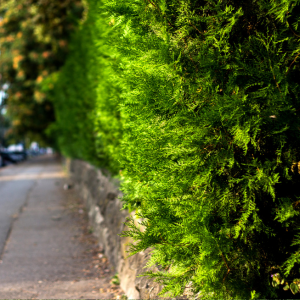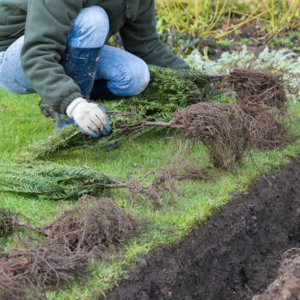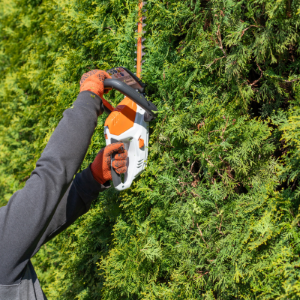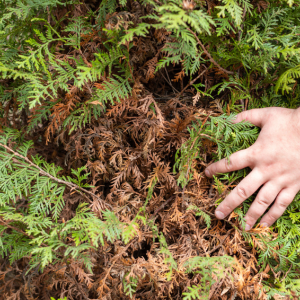Popular Fast-Growing Conifer Hedging - Leylandii
Hedges Direct stocks a variety of premium quality and stunning fast-growing conifers. This hedge plant species is popular to have in the garden, particularly Leylandii conifers, as they tend to grow the quickest. Western Red Cedar is another popular conifer species that grows exceptionally fast.
Did you know that the average Leylandii growth rate is 75-90cm a year - perfect if you're looking to achieve a tall hedge quickly?
Contrary to popular belief, the Leylandii conifer plant requires a similar amount of trimming and maintenance to any popular Laurel Hedge. When pruned, Leylandii is a relatively easy hedge to keep to a desired height and shape, making a great addition to any garden landscape.
Read Hedges Direct's article on High Hedge Disputes for more information about conifer hedge law. The article explains the legalities surrounding such disputes and hedging conifers.
Conifer Hedging Plants
Browse our selection of conifer hedging plants below or take a look at our evergreen hedging plants section for alternatives.
There are nearly 600 species of conifers hedge plants, including the popular Fir, Pine, Cypress, Yew, Cedar and Spruce. The best conifer hedging can be found in this section and are from the Cypress, Yew and Cedar family. We recommend planting conifer hedging when a dense, evergreen screen is required.
Advantages of Growing A Conifer Hedge


There's a reason why conifers are a common hedge type. It's a small screen to help reduce noise pollution and provide protection from strong winds. They're also one of the most favourable hedge plant types for urban and suburban areas where traffic and air pollution is at its highest.
These finely fronded hedges are adept at soaking up toxins from the air, especially traffic emissions due to the hedges being down at exhaust level.
Research has proven that they're far more effective than trees at removing particulates from the air in the immediate vicinity as a result.
Subsequently, this type of hedging has seen a resurgence in popularity for planting schemes in towns and cities. Hedging rather than walling or fencing also offers a more natural aesthetic and brings colour to built-up areas, also benefiting people's health and wellbeing.
Conifers are also perfect for lovely thick screens to offer the ultimate privacy, or indeed for hiding unsightly views. This is where the conifers come into their own, and due to them being a fast-growing hedge plant, they're one of the best hedges to provide cover, quickly.
Conifer Hedge Spacing
The conifer hedge plants that we supply vary significantly in size and each species has different growth characteristics; therefore, the planting density per metre alters following that. Recommended planting densities are indicated against each plant in the product table found on the relevant species page. However, conifers do grow reasonably quickly both in height and width, being substantially larger when they reach maturity and so sometimes, less is more!
You must plant according to the species requirements for growth, as well as for the eventual height of the hedge you want to achieve.


This is so that you can ensure that the plants have room to develop and don't unnecessarily encroach on each other. If your desired hedge height is anything up to 6ft, then you would need on average 2-3 plants per metre dependent upon initial height and size. However, if you're looking to grow a tall hedge that is 6ft plus, then planting only one plant every 60cm-100cm is adequate, although it will take a slightly more extended period for the hedge to knit into a seamless screen.
It's worth remembering that if they grow too densely and tightly packed, it can potentially restrict the airflow within the hedge, which can lead to conditions under which the plant is susceptible to bacterial or fungal infections.
Conifer Hedge Trimming


Conifer hedging is easy to trim and maintain; most of the conifer species only require maintenance twice a year. Being columnar, it's typically the height of the plant that requires the most attention with the vertical sides of the hedge perhaps only requiring a trim once a year. We recommend trimming and pruning once in early spring and then again in autumn. Leylandii is the exception. This conifer hedge plant species typically only requires a trim during the growing season, due to its swift growth.
When establishing, trim any off-shooting or wayward branches or growth with secateurs or shears.
Ensure the tools are sharp and disinfected before use to reduce the risk of damage or of disease taking hold after pruning.
When establishing, trim any off-shooting or wayward branches or growth with secateurs or shears. Ensure the tools are sharp and disinfected before use to reduce the risk of damage or of disease taking hold after pruning. Cut the branch at an angle of around 60 degrees but avoid cutting anywhere near the collar of the branch (the raised area of bark at the branch base), as this could damage it. Always trim larger branches several inches away from the collar. Use secateurs on branches smaller than 1/2" diameter and shears or a pruning saw on larger ones.
For established hedges, it's really simple to trim with hedge cutters as they allow you to just trim the extra shoots of growth. Click here to visit the Gardeners' World website to get step-by-step instructions on how to do this.
Trimming and Pruning: What Not To Do
- Don't trim out old growth (brown growth at the bottom or interior of the plant) as it can be damaging to the plant.
- Don't trim diseased branches near to the infected part. Cut at a healthy point to contain the disease but avoid cutting too near the collar of the branch.
- Never over prune or trim. Conifers prefer a lighter touch as they don't recover from hard pruning. Leave at least 4 inches of green growth where possible.
- Don't forget to water! Plants recover better from trimming and pruning if they're well watered. This is especially important in periods of extended dry weather or drought at which point trimming could severely imact plant health causing brown patches to appear or even kill the plant altogether.
Conifer Hedge Problems
If you notice your conifer hedge turning brown, it is important to identify the cause. Brown patches toward the exterior of the plant can be triggered from poorly timed pruning, i.e. pruning a conifer in summer when it has been consistently dry or hot. They can also be as a result of pests or disease. Conifers, like any other plant, have certain susceptabilities and can suffer from aphid or scale insect attack as well as certain fungal or baterial infections.
The RHS information page Conifers: Brown Patches has comprehensive information about the symptoms, causes, prevention and control and we'd recommend reading this if your hedge is displaying problem patches.


Frequently asked questions
When it comes to cutting tall conifers, safety is paramount. Hiring a professional tree surgeon or arborist experienced in working with tall trees should be your go-to. But, if you prefer to do it yourself, always follow safety guidelines, use a sturdy ladder that someone else can stabilise, and ensure that the tools you use are appropriate for the task. Start by trimming the lower branches before moving higher.
Conifers generally don't regenerate new growth when cut down to the ground level. Unlike deciduous hedges, which can sprout new shoots from their base, most conifers won't recover from severe pruning. However, selective pruning to remove specific branches or sections can stimulate new growth from the remaining branches.
If you are worried about your conifer regenerating after a hefty prune, choose the western red cedar (Thuja plicata) as this is more likely to regenerate on brown wood.
Cutting the top off a conifer can disrupt its natural growth pattern, causing a bare or uneven appearance. Conifers don't easily regenerate new growth from old wood, so it's best to avoid drastic pruning of the central leader. Instead, focus your shears on the side branches to maintain the desired shape and density while preserving the conifer's overall health and look.
Start by identifying the cause, which can range from drought stress to fungal infections or pest infestations. Dryness, frost, and pruning in hot summer temperatures can also cause conifers to change colour. Only prune lightly in April, June, or early August and apply a general fertiliser, followed by mulch, in winter to help it recover. Always try to avoid cutting back to brown wood when pruning.
Caring for conifers in pots is easy: ensure the pot has good drainage holes and use a well-draining potting mix. Water regularly, allowing the soil to dry out slightly between waterings. Provide adequate sunlight, as most conifers thrive in full sun or partial shade. You can also fertilise the conifer during the growing season with a balanced, slow-release fertiliser. Prune lightly to maintain the desired shape and size, and repot the conifer every few years to refresh the soil and promote healthy growth. Always ensure the pots are a lot larger and deeper than the root system of the plant, or they will dry out quickly and will become pot bound sooner.
Dealing with a wasp nest in a conifer tree can be challenging and potentially dangerous. It's best to contact a professional pest control service that specialises in wasp nest removal, as they’ll have the expertise and protective equipment to handle the situation safely.
Conifer hedges generally prefer full sun to partial shade, but they can tolerate slight shade as long as their other growing conditions are met. If you're planning to plant conifer hedges in a shaded area, choose shade-tolerant varieties like English yew or Western Red Cedar.
 Hedges Direct
Hedges Direct 



